Sociology, 12 th Edition by John Macionis Copyright
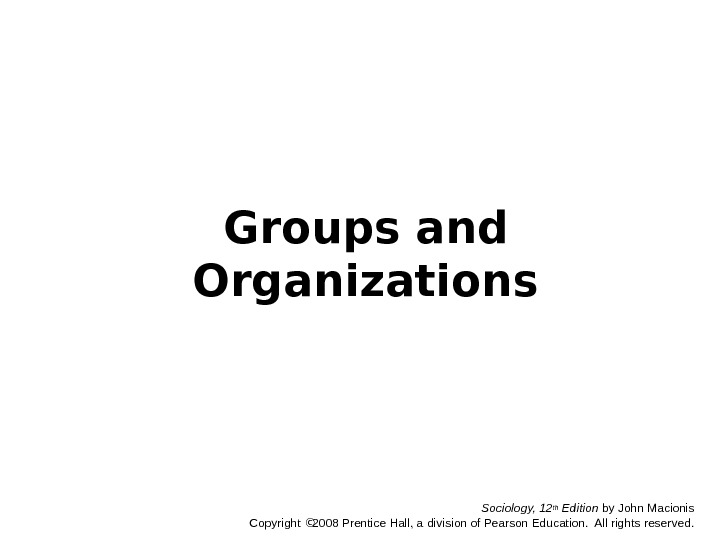
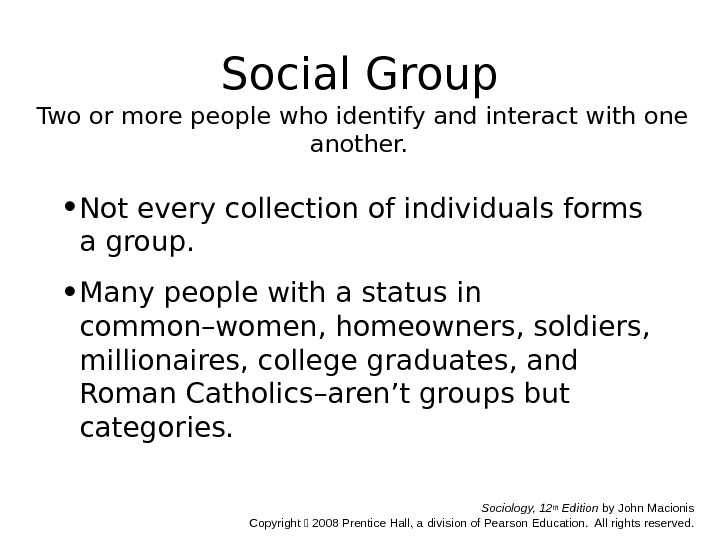
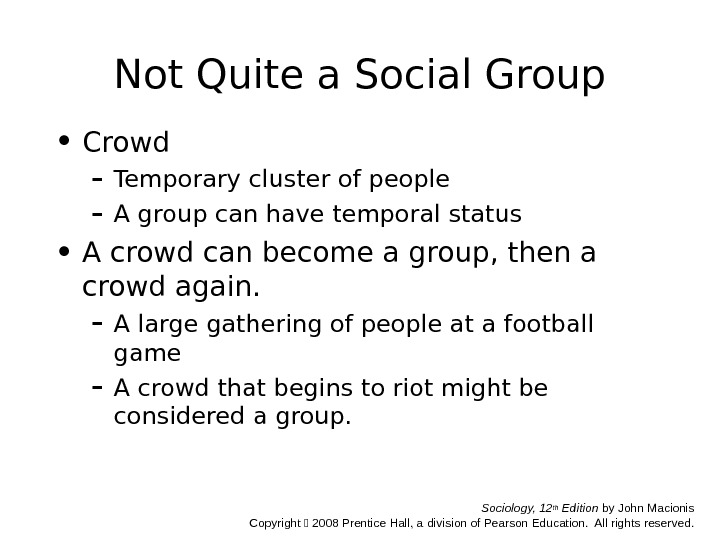
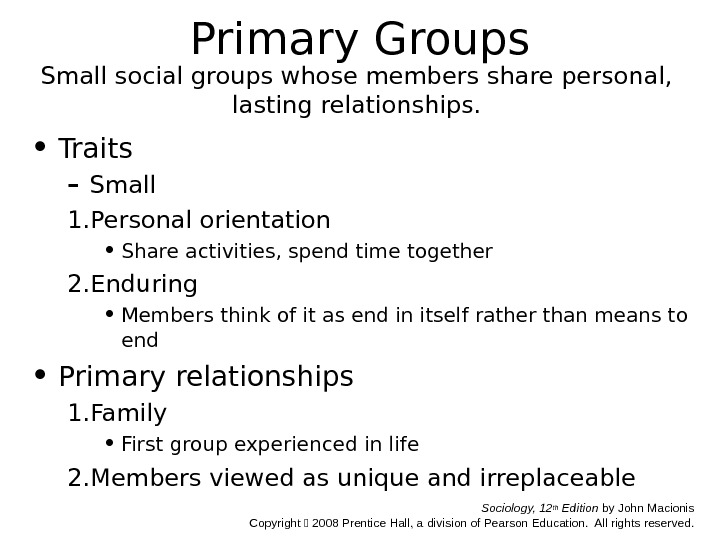
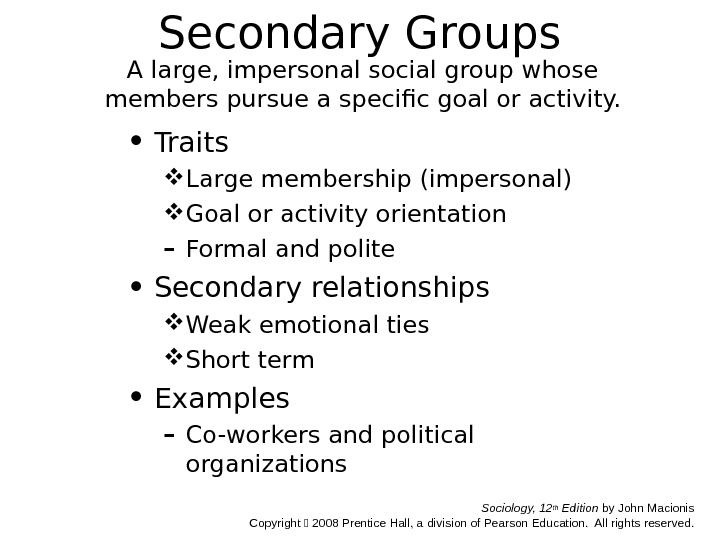
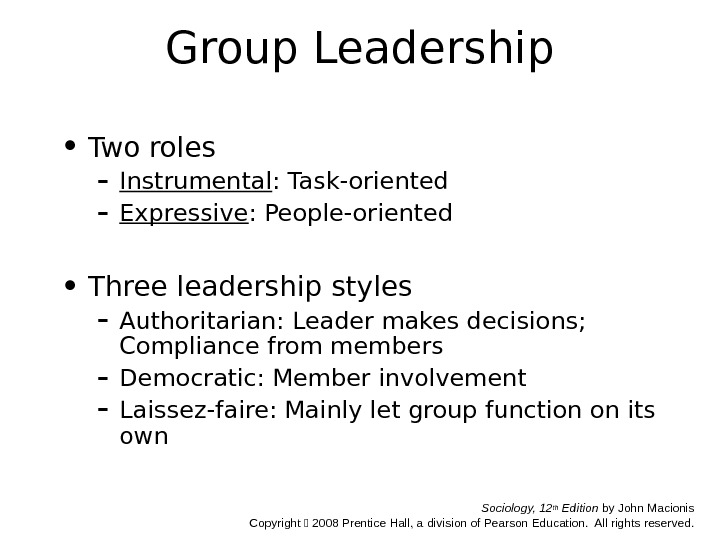


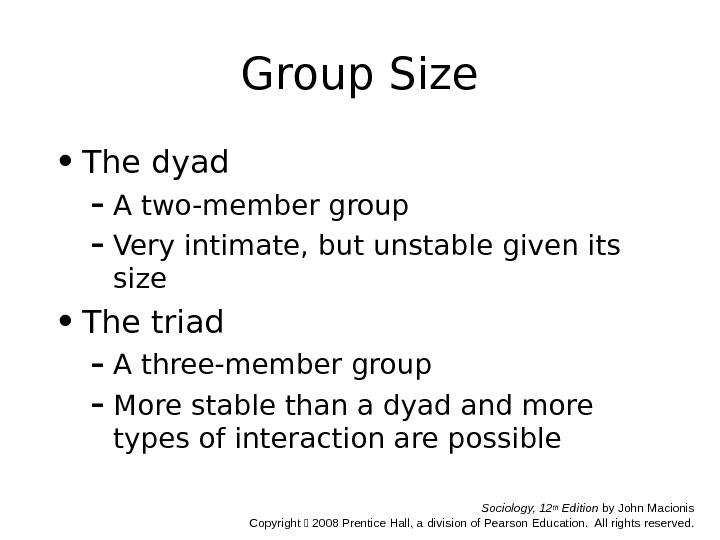
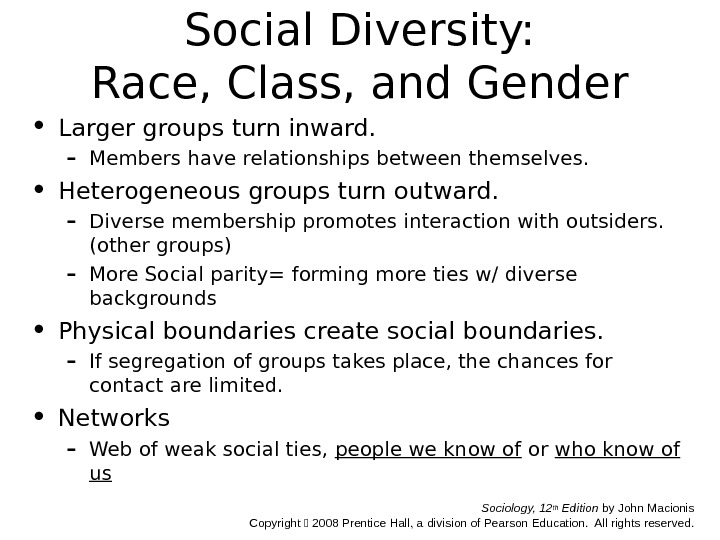
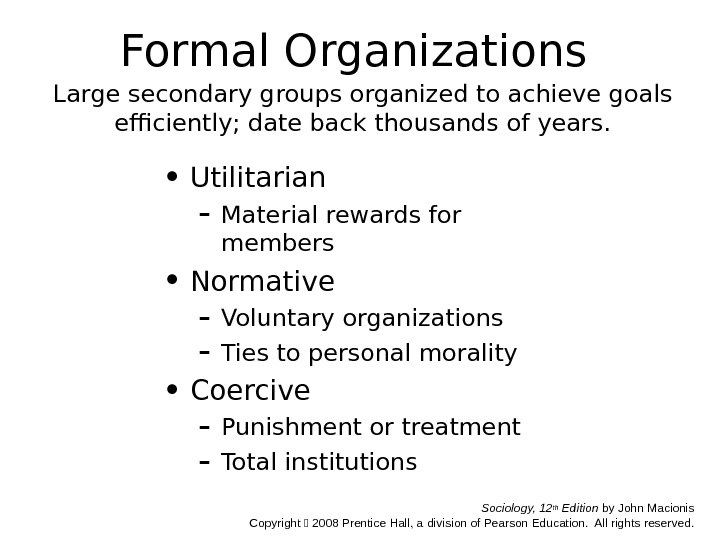
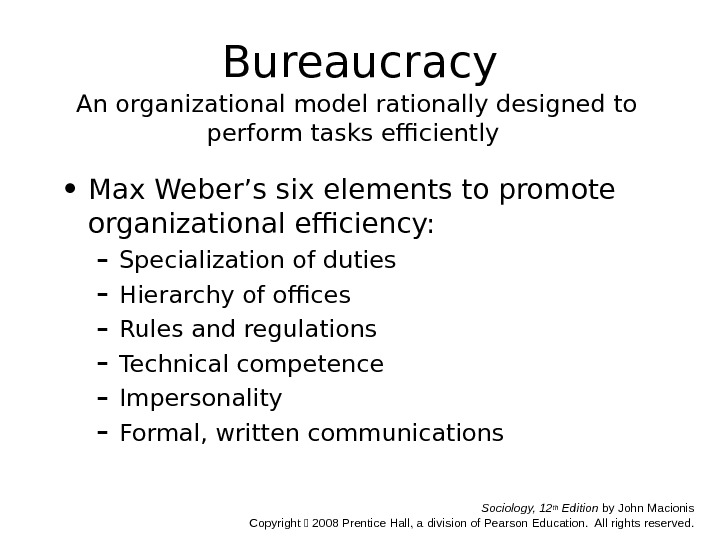
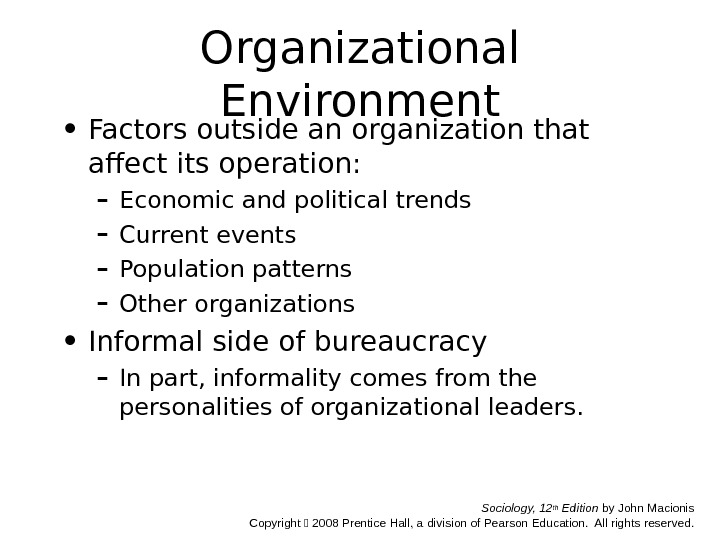
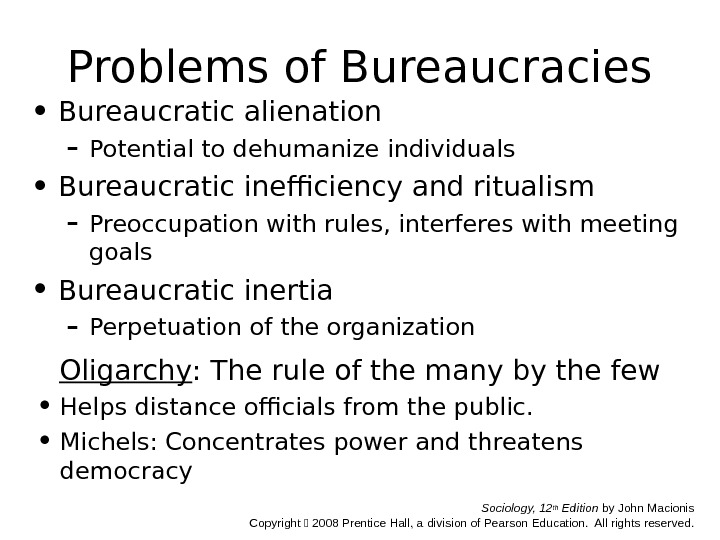

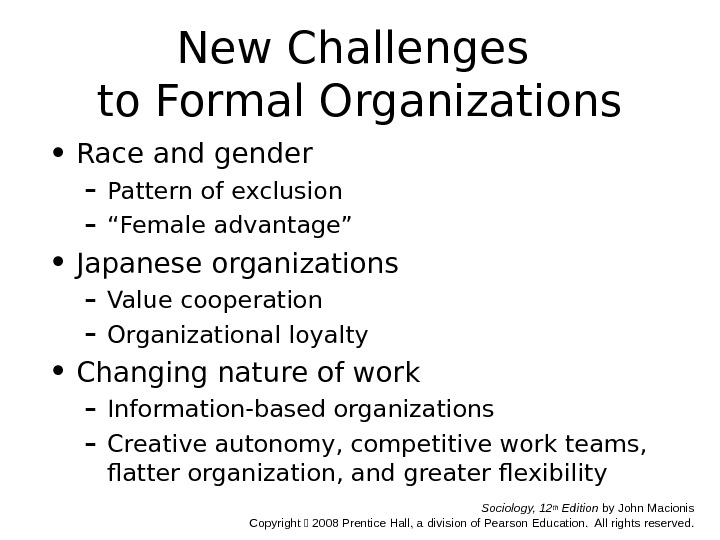
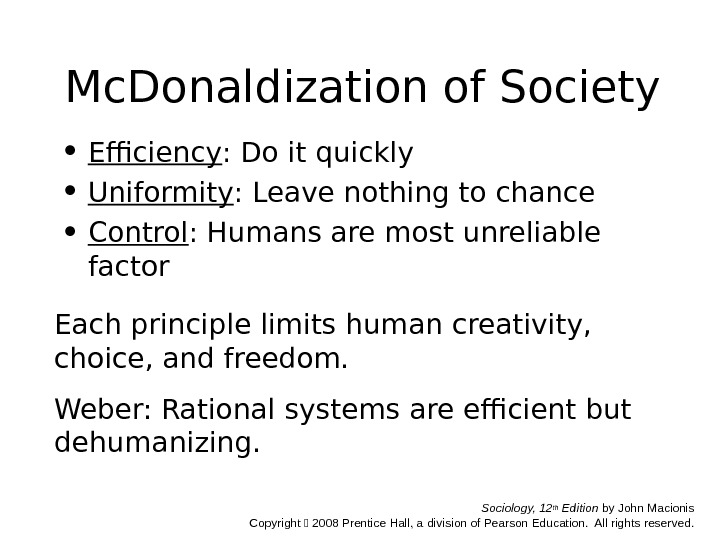
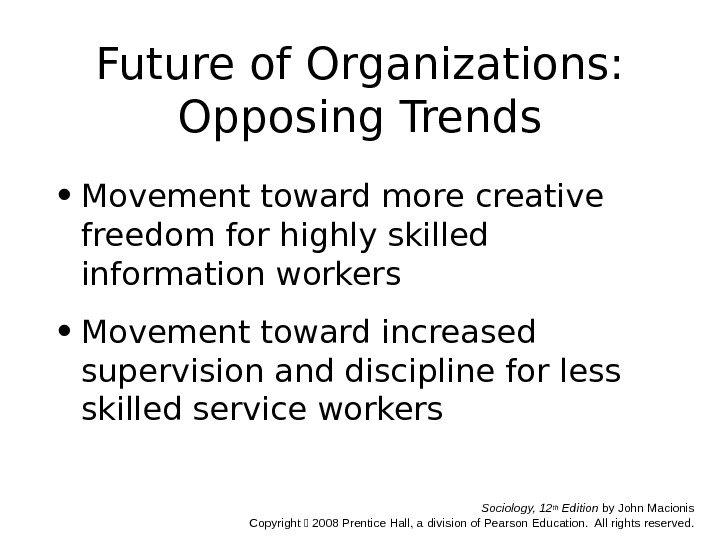
groups_and_organizations.ppt
- Размер: 330 Кб
- Количество слайдов: 18
Описание презентации Sociology, 12 th Edition by John Macionis Copyright по слайдам
 Sociology, 12 th Edition by John Macionis Copyright 2008 Prentice Hall, a division of Pearson Education. All rights reserved. Groups and Organizations
Sociology, 12 th Edition by John Macionis Copyright 2008 Prentice Hall, a division of Pearson Education. All rights reserved. Groups and Organizations
 Sociology, 12 th Edition by John Macionis Copyright 2008 Prentice Hall, a division of Pearson Education. All rights reserved. Social Group Two or more people who identify and interact with one another. • Not every collection of individuals forms a group. • Many people with a status in common–women, homeowners, soldiers, millionaires, college graduates, and Roman Catholics–aren’t groups but categories.
Sociology, 12 th Edition by John Macionis Copyright 2008 Prentice Hall, a division of Pearson Education. All rights reserved. Social Group Two or more people who identify and interact with one another. • Not every collection of individuals forms a group. • Many people with a status in common–women, homeowners, soldiers, millionaires, college graduates, and Roman Catholics–aren’t groups but categories.
 Sociology, 12 th Edition by John Macionis Copyright 2008 Prentice Hall, a division of Pearson Education. All rights reserved. Not Quite a Social Group • Crowd – Temporary cluster of people – A group can have temporal status • A crowd can become a group, then a crowd again. – A large gathering of people at a football game – A crowd that begins to riot might be considered a group.
Sociology, 12 th Edition by John Macionis Copyright 2008 Prentice Hall, a division of Pearson Education. All rights reserved. Not Quite a Social Group • Crowd – Temporary cluster of people – A group can have temporal status • A crowd can become a group, then a crowd again. – A large gathering of people at a football game – A crowd that begins to riot might be considered a group.
 Sociology, 12 th Edition by John Macionis Copyright 2008 Prentice Hall, a division of Pearson Education. All rights reserved. Primary Groups • Traits – Small 1. Personal orientation • Share activities, spend time together 2. Enduring • Members think of it as end in itself rather than means to end • Primary relationships 1. Family • First group experienced in life 2. Members viewed as unique and irreplaceable. Small social groups whose members share personal, lasting relationships.
Sociology, 12 th Edition by John Macionis Copyright 2008 Prentice Hall, a division of Pearson Education. All rights reserved. Primary Groups • Traits – Small 1. Personal orientation • Share activities, spend time together 2. Enduring • Members think of it as end in itself rather than means to end • Primary relationships 1. Family • First group experienced in life 2. Members viewed as unique and irreplaceable. Small social groups whose members share personal, lasting relationships.
 Sociology, 12 th Edition by John Macionis Copyright 2008 Prentice Hall, a division of Pearson Education. All rights reserved. Secondary Groups • Traits Large membership (impersonal) Goal or activity orientation – Formal and polite • Secondary relationships Weak emotional ties Short term • Examples – Co-workers and political organizations. A large, impersonal social group whose members pursue a specific goal or activity.
Sociology, 12 th Edition by John Macionis Copyright 2008 Prentice Hall, a division of Pearson Education. All rights reserved. Secondary Groups • Traits Large membership (impersonal) Goal or activity orientation – Formal and polite • Secondary relationships Weak emotional ties Short term • Examples – Co-workers and political organizations. A large, impersonal social group whose members pursue a specific goal or activity.
 Sociology, 12 th Edition by John Macionis Copyright 2008 Prentice Hall, a division of Pearson Education. All rights reserved. Group Leadership • Two roles – Instrumental : Task-oriented – Expressive : People-oriented • Three leadership styles – Authoritarian: Leader makes decisions; Compliance from members – Democratic: Member involvement – Laissez-faire: Mainly let group function on its own
Sociology, 12 th Edition by John Macionis Copyright 2008 Prentice Hall, a division of Pearson Education. All rights reserved. Group Leadership • Two roles – Instrumental : Task-oriented – Expressive : People-oriented • Three leadership styles – Authoritarian: Leader makes decisions; Compliance from members – Democratic: Member involvement – Laissez-faire: Mainly let group function on its own
 Sociology, 12 th Edition by John Macionis Copyright 2008 Prentice Hall, a division of Pearson Education. All rights reserved. Group Conformity Studies • Asch’s research – Willingness to compromise our own judgments • Milgram’s research – Role authority plays – Following orders • Janis’s research – Negative side of groupthink. Groupthink: Tendency of group members to conform, resulting in a narrow view of some issue
Sociology, 12 th Edition by John Macionis Copyright 2008 Prentice Hall, a division of Pearson Education. All rights reserved. Group Conformity Studies • Asch’s research – Willingness to compromise our own judgments • Milgram’s research – Role authority plays – Following orders • Janis’s research – Negative side of groupthink. Groupthink: Tendency of group members to conform, resulting in a narrow view of some issue
 Sociology, 12 th Edition by John Macionis Copyright 2008 Prentice Hall, a division of Pearson Education. All rights reserved. Reference Group • Stouffer’s research – We compare ourselves in relation to specific reference groups. • In-groups and out-groups – Loyalty to in-group – Opposition to out-groups. A social group that serves as a point of reference in making evaluations and decisions
Sociology, 12 th Edition by John Macionis Copyright 2008 Prentice Hall, a division of Pearson Education. All rights reserved. Reference Group • Stouffer’s research – We compare ourselves in relation to specific reference groups. • In-groups and out-groups – Loyalty to in-group – Opposition to out-groups. A social group that serves as a point of reference in making evaluations and decisions
 Sociology, 12 th Edition by John Macionis Copyright 2008 Prentice Hall, a division of Pearson Education. All rights reserved. Group Size • The dyad – A two-member group – Very intimate, but unstable given its size • The triad – A three-member group – More stable than a dyad and more types of interaction are possible
Sociology, 12 th Edition by John Macionis Copyright 2008 Prentice Hall, a division of Pearson Education. All rights reserved. Group Size • The dyad – A two-member group – Very intimate, but unstable given its size • The triad – A three-member group – More stable than a dyad and more types of interaction are possible
 Sociology, 12 th Edition by John Macionis Copyright 2008 Prentice Hall, a division of Pearson Education. All rights reserved. Social Diversity: Race, Class, and Gender • Larger groups turn inward. – Members have relationships between themselves. • Heterogeneous groups turn outward. – Diverse membership promotes interaction with outsiders. (other groups) – More Social parity= forming more ties w/ diverse backgrounds • Physical boundaries create social boundaries. – If segregation of groups takes place, the chances for contact are limited. • Networks – Web of weak social ties, people we know of or who know of us
Sociology, 12 th Edition by John Macionis Copyright 2008 Prentice Hall, a division of Pearson Education. All rights reserved. Social Diversity: Race, Class, and Gender • Larger groups turn inward. – Members have relationships between themselves. • Heterogeneous groups turn outward. – Diverse membership promotes interaction with outsiders. (other groups) – More Social parity= forming more ties w/ diverse backgrounds • Physical boundaries create social boundaries. – If segregation of groups takes place, the chances for contact are limited. • Networks – Web of weak social ties, people we know of or who know of us
 Sociology, 12 th Edition by John Macionis Copyright 2008 Prentice Hall, a division of Pearson Education. All rights reserved. Formal Organizations • Utilitarian – Material rewards for members • Normative – Voluntary organizations – Ties to personal morality • Coercive – Punishment or treatment – Total institutions. Large secondary groups organized to achieve goals efficiently; date back thousands of years.
Sociology, 12 th Edition by John Macionis Copyright 2008 Prentice Hall, a division of Pearson Education. All rights reserved. Formal Organizations • Utilitarian – Material rewards for members • Normative – Voluntary organizations – Ties to personal morality • Coercive – Punishment or treatment – Total institutions. Large secondary groups organized to achieve goals efficiently; date back thousands of years.
 Sociology, 12 th Edition by John Macionis Copyright 2008 Prentice Hall, a division of Pearson Education. All rights reserved. Bureaucracy • Max Weber’s six elements to promote organizational efficiency: – Specialization of duties – Hierarchy of offices – Rules and regulations – Technical competence – Impersonality – Formal, written communications. An organizational model rationally designed to perform tasks efficiently
Sociology, 12 th Edition by John Macionis Copyright 2008 Prentice Hall, a division of Pearson Education. All rights reserved. Bureaucracy • Max Weber’s six elements to promote organizational efficiency: – Specialization of duties – Hierarchy of offices – Rules and regulations – Technical competence – Impersonality – Formal, written communications. An organizational model rationally designed to perform tasks efficiently
 Sociology, 12 th Edition by John Macionis Copyright 2008 Prentice Hall, a division of Pearson Education. All rights reserved. Organizational Environment • Factors outside an organization that affect its operation: – Economic and political trends – Current events – Population patterns – Other organizations • Informal side of bureaucracy – In part, informality comes from the personalities of organizational leaders.
Sociology, 12 th Edition by John Macionis Copyright 2008 Prentice Hall, a division of Pearson Education. All rights reserved. Organizational Environment • Factors outside an organization that affect its operation: – Economic and political trends – Current events – Population patterns – Other organizations • Informal side of bureaucracy – In part, informality comes from the personalities of organizational leaders.
 Sociology, 12 th Edition by John Macionis Copyright 2008 Prentice Hall, a division of Pearson Education. All rights reserved. Problems of Bureaucracies • Bureaucratic alienation – Potential to dehumanize individuals • Bureaucratic inefficiency and ritualism – Preoccupation with rules, interferes with meeting goals • Bureaucratic inertia – Perpetuation of the organization Oligarchy : The rule of the many by the few • Helps distance officials from the public. • Michels: Concentrates power and threatens democracy
Sociology, 12 th Edition by John Macionis Copyright 2008 Prentice Hall, a division of Pearson Education. All rights reserved. Problems of Bureaucracies • Bureaucratic alienation – Potential to dehumanize individuals • Bureaucratic inefficiency and ritualism – Preoccupation with rules, interferes with meeting goals • Bureaucratic inertia – Perpetuation of the organization Oligarchy : The rule of the many by the few • Helps distance officials from the public. • Michels: Concentrates power and threatens democracy
 Sociology, 12 th Edition by John Macionis Copyright 2008 Prentice Hall, a division of Pearson Education. All rights reserved. The Evolution of Formal Organizations Scientific Management Application of scientific principles to the operation of a business or large organization 1. Identify tasks and time needed for tasks 2. Analyze to perform tasks more efficiently 3. Provide incentives for worker efficiency
Sociology, 12 th Edition by John Macionis Copyright 2008 Prentice Hall, a division of Pearson Education. All rights reserved. The Evolution of Formal Organizations Scientific Management Application of scientific principles to the operation of a business or large organization 1. Identify tasks and time needed for tasks 2. Analyze to perform tasks more efficiently 3. Provide incentives for worker efficiency
 Sociology, 12 th Edition by John Macionis Copyright 2008 Prentice Hall, a division of Pearson Education. All rights reserved. New Challenges to Formal Organizations • Race and gender – Pattern of exclusion – “ Female advantage” • Japanese organizations – Value cooperation – Organizational loyalty • Changing nature of work – Information-based organizations – Creative autonomy, competitive work teams, flatter organization, and greater flexibility
Sociology, 12 th Edition by John Macionis Copyright 2008 Prentice Hall, a division of Pearson Education. All rights reserved. New Challenges to Formal Organizations • Race and gender – Pattern of exclusion – “ Female advantage” • Japanese organizations – Value cooperation – Organizational loyalty • Changing nature of work – Information-based organizations – Creative autonomy, competitive work teams, flatter organization, and greater flexibility
 Sociology, 12 th Edition by John Macionis Copyright 2008 Prentice Hall, a division of Pearson Education. All rights reserved. Mc. Donaldization of Society • Efficiency : Do it quickly • Uniformity : Leave nothing to chance • Control : Humans are most unreliable factor Each principle limits human creativity, choice, and freedom. Weber: Rational systems are efficient but dehumanizing.
Sociology, 12 th Edition by John Macionis Copyright 2008 Prentice Hall, a division of Pearson Education. All rights reserved. Mc. Donaldization of Society • Efficiency : Do it quickly • Uniformity : Leave nothing to chance • Control : Humans are most unreliable factor Each principle limits human creativity, choice, and freedom. Weber: Rational systems are efficient but dehumanizing.
 Sociology, 12 th Edition by John Macionis Copyright 2008 Prentice Hall, a division of Pearson Education. All rights reserved. Future of Organizations: Opposing Trends • Movement toward more creative freedom for highly skilled information workers • Movement toward increased supervision and discipline for less skilled service workers
Sociology, 12 th Edition by John Macionis Copyright 2008 Prentice Hall, a division of Pearson Education. All rights reserved. Future of Organizations: Opposing Trends • Movement toward more creative freedom for highly skilled information workers • Movement toward increased supervision and discipline for less skilled service workers
